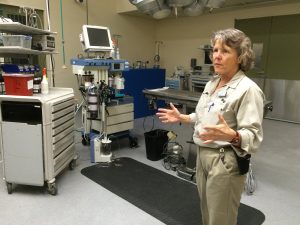Zoo InternQuest is a seven-week career exploration program for San Diego County high school juniors and seniors. Students have the unique opportunity to meet professionals working for the San Diego Zoo, Safari Park, and Institute for Conservation Research, learn about their jobs, and then blog about their experience online. Follow their adventures here on the Zoo’s website!
 Becoming a veterinarian is a dream for many. Dr. Meg Sutherland-Smith and Dr. Ben Nevitt provided interns some insight into life as a veterinarian at the San Diego Zoo. Dr. Sutherland-Smith is the Director of Veterinary Services and has been working with the Zoo for 26 years. Dr. Nevitt is also a veterinarian and has been working at the Zoo for two and a half years.
Becoming a veterinarian is a dream for many. Dr. Meg Sutherland-Smith and Dr. Ben Nevitt provided interns some insight into life as a veterinarian at the San Diego Zoo. Dr. Sutherland-Smith is the Director of Veterinary Services and has been working with the Zoo for 26 years. Dr. Nevitt is also a veterinarian and has been working at the Zoo for two and a half years.
The path to becoming a veterinarian is a long one. Undergraduate school takes four years, vet school is another four years, internships is a minimum of one year, and then three years of residency; that is a total of 12 years! Dr. Sutherland-Smith said that her desire to work with animals was what motivated her to get through all of the schooling. Some of her fondest memories involve the excitement she felt when she got the chance to work with animals. Luckily, future veterinarians start to work with animals during their undergraduate school. Dr. Nevitt and Dr. Sutherland-Smith both said that being well-rounded and having experience is important for both getting into a good vet program and also getting the job that you want. Dr. Nevitt researched at St. Louis College for three years and Dr. Sutherland-Smith volunteered at the National Zoo for two summers and they both feel that those experiences were very important to getting the job they have today.
Now that you know what it takes to become a vet, let’s see what a day in a veterinarian’s life is like. At the Zoo, the vets work in the clinic usually for four days a week; this involves check ups and procedures that are usually finished by twelve in the afternoon. Dr. Nevitt says he starts his day at seven in the morning and, in theory, ends his day at five. However, Dr. Sutherland-Smith says, “There’s no such thing as an eight hour day.” The vets can be stuck in the clinic for hours with emergency cases and the vets even rotate being on call, which means they can be brought back into work at anytime that night. But being a veterinarian doesn’t mean you’ll always be working with the animals, vets have their fair share of paperwork to fill out too.
Working as a veterinarian keeps you on your toes, and that is exactly why vets love their jobs. Dr. Nevitt’s favorite cases are the baby cases. His absolute favorite baby case was when he was on 24-hour care for a baby bottlenose dolphin that was rejected by his mother. Dr. Nevitt successfully raised a healthy dolphin and he says that was one of his most rewarding cases of his career thus far. However, being a vet has its lows too. Treating and diagnosing animals is incredibly difficult and it can get depressing and frustrating when many cases do not have a positive outcome. Dr. Sutherland-Smith recalls one of her recent difficult cases in which a harpy eagle died from a heart deformation. In this case there was no way to diagnose this issue which Dr. Sutherland-Smith says can be one of the most frustrating part of being a vet. She says that as a vet your favorite animal is a healthy animal.
Becoming a vet is a long, labor-intensive road; so here is some advice from the veterinarians at the Zoo. Keep on learning and teaching others. Always focus on the bigger picture. When your homework is piling up or your cases just aren’t turning out right, remember that the path you are following will benefit the lives of thousands of animals and contribute to the conservation of the planet.
Sarah, Careers Team
Week Five, Fall Session 2016


